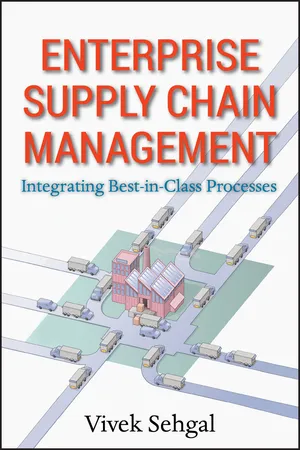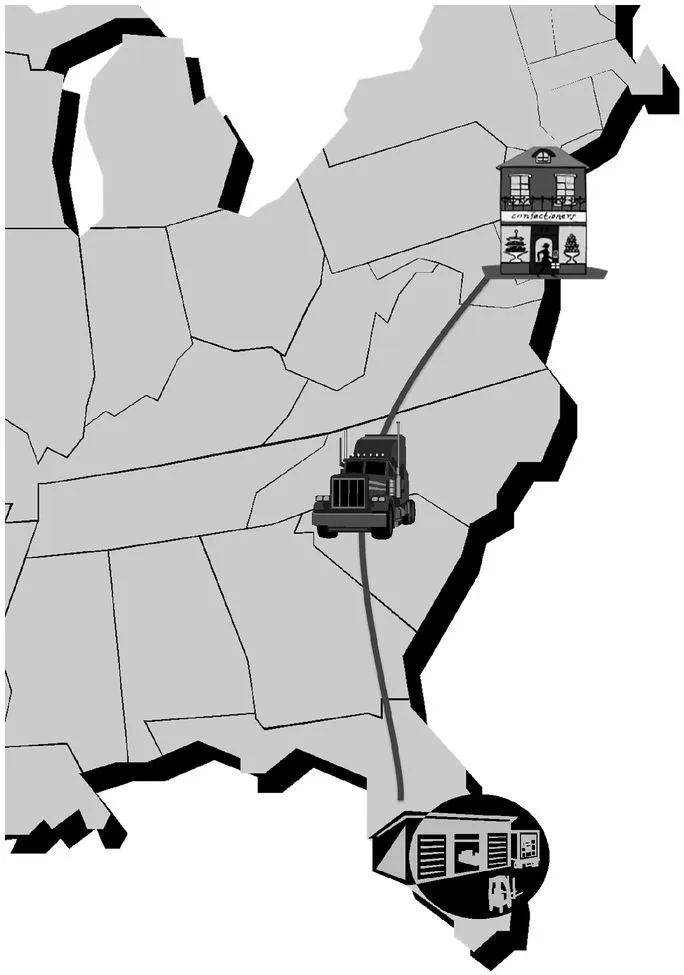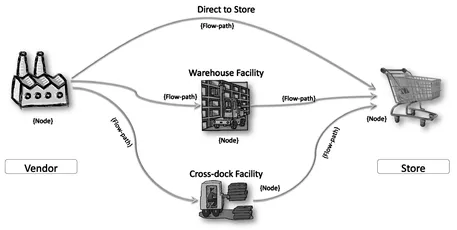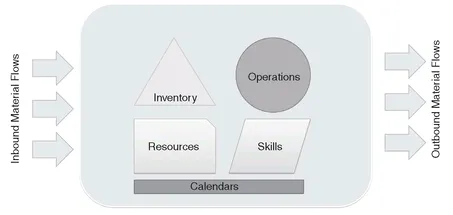![]()
PART I
Introduction
![]()
CHAPTER 1
What Is a Supply Chain?
Various definitions abound for supply chain. These definitions change with the industry vertical and the context. We will stick to a generic definition that defines supply chain as the flow and management of resources across the enterprise for the purpose of maintaining the business operations profitably. This really is an extremely generic definition, and therefore may be fuzzy at first, but we will examine the components of the definition, and a picture of a supply chain will soon emerge.
Definitions
Resources in this definition can be materials, people, information, money, or any other such resources that must be managed for profitable business operations.
Materials can be raw materials, work-in-progress (WIP), or finished products. In the context of retail industries, it is the merchandise that the retailers sell. It costs to buy this merchandise, store it, and distribute it. If a store is out of merchandise, it loses the sale, thus affecting revenue; if it is overstocked, it increases the inventory, affecting operating cash flow negatively. Some of this merchandise may be seasonal, and therefore must be planned based on seasonal patterns. It may be local (e.g., folding portable chairs with your favorite team’s logo on the back), may depend on weather (e.g., snow boots and jackets), or may need to be custom ordered (e.g., purple carpet). All these factors make the merchandise a resource to be managed. This illustrates the “right-time, right-place, right-quantity” mantra that you may have heard in relation to supply chain management.
People can also become constraints that must be managed for profitable operations. In a supply chain context for retailers, think of the distribution center associates that must be available to receive and ship all the planned merchandise from a warehouse in a given day. For manufacturers, this relates to the direct labor.
Management of the flow of information is equally important to smooth operations. Extending the distribution center example, if the information on inbound shipments to the warehouse is not visible to the warehouse manager, it can create problems for labor scheduling as well as downstream fulfillment planning for the store orders. In fact, visibility across supply chain functions that can provide a consolidated view of demand, inventories, and orders has emerged as one of the most important and valued functions in most companies.
Money is another resource. Often, the objective of a lot of supply chain planning and execution initiatives is to minimize the cost of doing business (or maximize the profitability).
Other resources can be physical assets such as buildings and machinery. Manufacturers routinely plan operations for their factories with the intent of maximizing the utilization of most critical assets. Retailers can sometimes find themselves in a fix when the number of trailers they manage falls short of the shipments they need to send to their stores, or when the warehouse capacity is too small for the inventory they must hold for ramping up to the holiday season.
Flow and management of these resources is key to supply chain management. Some of the resources actually flow through the supply chain, such as merchandise. It flows from the suppliers’ warehouses to the retailer’s warehouses, then to their stores or customers. Others help the flow of this merchandise, such as workers in the distribution center. Recall that the objective of a well-managed supply chain is to plan and execute the flow and management of the resources for the purpose of maintaining the business operations profitably. Recall also that the resources are generally scarce and cost money. Putting these two together, the emphasis on profitability becomes clear. If your supply chain can achieve this better than your competitor’s, you are in good shape. If not, supply chain improvements can help.
Across the enterprise refers to the extended footprint of supply chain operations as it straddles the planning and execution processes across several functions. These processes cover planning processes like demand and supply planning, and then continue with the execution processes of purchasing, manufacturing, stocking, and distribution of inventory through a network of warehouses and transportation resources.
The final words in our definition refer to the profitability. Supply chain processes directly affect the costs of planning and operations, and therefore provide extraordinary opportunities to reduce the cost of goods sold (COGS) and improve asset turnover, thereby enhancing profitability of a corporation. A quick primer on how supply chain improvements affect the corporate finances is provided in Appendix D.
Physical Manifestation of a Supply Chain
Now that the definition in theory is behind us, let us look at the physical manifestation of supply chains. This is easier to understand with an example. We will look at a typical retailer with stores and warehouses; though some retailers, such as grocers, may also have manufacturing facilities as part of their supply chains. All retail supply chains have distribution-intensive operations irrespective of the specific retail segment they represent. Examples of these retail segments are soft-line retailers like apparel chains, hard-line retailers like home-improvement chains, or department stores.
Most retailers have brick-and-mortar stores where the merchandise is presented for the customers to buy. Some of the new-breed retailers (such as Amazon.com) may not have physical stores, but they do provide an environment where the merchandise and customers can interact. Physical or not, the stores fulfill the same function—they bring the merchandise and the customers together and provide an environment conducive to sales.
The merchandise arrives in the stores from the retailer’s own warehouses, or directly from the supplier’s warehouse. All of these (namely the store, retailer’s warehouse, and the supplier’s warehouse) together represent the physical supply chain.
As shown in Exhibit 1.1, if the store is in New Jersey, and the supplying warehouse in Florida, then the merchandise may be carried on a truck along I-95. The elements in italics represent respectively the demand location, supplying location, product, transport resource, and route. Together, all of these constitute elements of the supply chain that must be managed by the retailer to smoothly serve the customer.
When customers buy, the stores need to replenish the merchandise. This merchandise is typically replenished from the warehouses. But the warehouses themselves need to be replenished with merchandise from the vendors. That brings us to the purchase orders against which such merchandise is supplied by the vendors.
Before any purchases can be made, we need to establish the total customer demand, existing supplies, and remaining demand that must be fulfilled from new purchases. The purchase orders are therefore planned through a process that computes the demand for merchandise at each of the locations and predicts how much should be bought, where, and when. As these purchases must be made in advance of actual demand, the demand planning processes help in establishing the projected (forecast) demand, and merchandise planning processes establish assortments to decide what will be sold where. We will touch on all of these processes in the following chapters.
EXHIBIT 1.1 Basic Elements of a Supply Chain
Elements of a Supply Chain Model
Now that we have a fairly good idea about the physical components of a supply chain, let us look at how a typical supply chain is modeled to support the business processes. Supply chains have two ends: the demand end and the supply end.
The demand end of the supply chain models elements of the supply chain where the demand originates. Examples of the demand end are stores, a Web-storefront, or customers. Business requirements determine whether individual customers in a supply chain are modeled. For most retail operations catering to individuals, this may not be required; but think of a manufacturer with a wholesale operation and you might want to model the customers as well. Whether one models the stores at this end, or the end-customers, depends on the level at which a consistent demand pattern exists, which also can be easily modeled. For example, for a large retailer with thousands of stores and individual cash-and-carry customers, stores may be very well suited to model demand. However, for a consumer goods manufacturer like Procter & Gamble, large individual customers like Wal-Mart or Target will be better suited to model demand. We will also call this end of the supply chain the downstream. Exhibit 1.2 shows the demand and supply ends of a supply chain.
The supply end of a supply chain represents the sources of supply, such as suppliers’ warehouses or a factory. These represent the supply chain elements that provide supplies to address the demand generated at the other end of the supply chain. We will call this end of the supply chain the upstream.
Thinking of the supply chain in terms of demand end and a supply end also helps in understanding one of the core problems that supply chains solve—that of balancing supplies against demand. Demand flows from downstream nodes to the upstream nodes in a supply chain network, while the supplies flow from the upstream nodes to the downstream nodes.
EXHIBIT 1.2 Demand and Supply Ends of a Supply Chain
EXHIBIT 1.3 Supply Chain Nodes and Flow-paths
Between the supply and demand ends of a supply chain are modeled other elements that constitute the distribution network. Examples of these elements are warehouses, cross-docking facilities, transshipment points, processing facilities, assembly plants, and so on.
All the elements we have mentioned here are different types of locations. We will call them nodes. The relationships among these nodes are also modeled in a supply chain to establish the valid paths along which goods/services can travel. We will call these paths flow-paths.
As depicted in Exhibit 1.3, the network of nodes and flow-paths in the supply chain model creates the supply chain network. Though it may not be identical, the supply chain network model closely mirrors the physical supply chain for a retailer.
Attributes of a Supply Chain Node
A node in a supply chain model generally represents a type of location along with its inventory, operations, resources, skills, and any other attributes relevant to supply chain operations. Nodes add value to the material flowing through the supply chain. Exhibit 1.4 shows a supply chain node and the typical elements that can be defined at a node.
Nodes typically model locations. Locations can be used to represent a manufacturing location (such as a factory), distribution location (such as a warehouse), selling location (such as a store), or a supplying location (such as a vendor/warehouse). Locations can have multiple purposes as well. For example, a factory may also serve as a warehouse.
EXHIBIT 1.4 Anatomy of a Supply Chain Node
Inventory is consumed, produced, or distributed through these nodes. For example, inventory is consumed at the stores as customers buy the merchandise. Raw material is consumed at factories, and finished goods are produced in turn. A warehouse distributes the goods.
Operations are performed at these nodes. These operations can vary from manufacturing activi...




